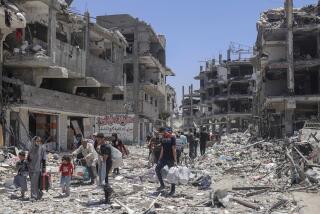25% of Kuwaitis May Be Casualties, U.S. Believes : Aftermath: Providing food, water and medical care ‘will stretch world relief organizations’ to the maximum.
- Share via
WASHINGTON — As much as 25% of Kuwait’s civilian population may be dead, injured or suffering from such diseases as cholera and dysentery by the time the country is free of Iraqi troops, U.S. Army analysts predict.
The analysis, contained in a detailed report prepared by Army civil affairs units to guide allied forces that will occupy Kuwait, paints a picture of a ravaged country whose capital city could be virtually razed if Iraqi defenders put up a fight against allied troops.
For the record:
12:00 a.m. March 3, 1991 For the Record
Los Angeles Times Sunday March 3, 1991 Home Edition Part A Page 3 Column 4 Metro Desk 2 inches; 44 words Type of Material: Correction
Casualty estimates--An article published Tuesday involving estimates of potential civilian casualties in Kuwait inadvertently failed to mention the source of the report that formed the basis of the article. The report was obtained from Pacific News Service, which had received it from a Pentagon official.
Providing food, water and rudimentary medical care to the roughly 800,000 people still in Kuwait “will stretch world relief organizations to their maximum capacities,” the report estimates. A copy of the unclassified document was obtained by The Times.
Already, the plans say, dysentery has become “commonplace” among civilian Kuwaitis, 40% of whom are under the age of 15.
“Large numbers of children may be lost” to epidemics of viral disease spread by unsanitary conditions, and tens of thousands more could die if Iraqi troops battle to hold the city, according to the planners.
Even more civilians could die once formal fighting stops because “terrorist action is expected from stay-behind Palestinian or Iraqi personnel,” says the report, which was compiled before Baghdad Radio announced Monday that Saddam Hussein had ordered his troops to pull out of Kuwait.
In addition to cholera, which is widespread in the Middle East, “episodes of plague have been reported in recent years” in Kuwait and could recur, the report says.
Rats, feeding on 288 million pounds of unburied garbage that has accumulated in and around Kuwait city since Iraq’s Aug. 2 invasion, already pose a serious threat.
Before the invasion, more than 1.8 million people lived in Kuwait. More than 1 million have since fled. Of the remaining population, about 100,000 could be injured and 40,000 killed if Iraq follows a “scorched earth” defense of the city, the plan estimates.
Thousands more are expected to be laid low by disease.
Also, if Iraqi troops must be ejected from Kuwait city in house-to-house battles, military planners expect that much of the urban area could be destroyed.
Even if such a battle does not take place, Kuwait’s vital infrastructure--from water plants and generators to roads and bridges--already has been badly damaged, with vast amounts of equipment dismantled and taken north to Iraq.
The document envisions that occupation forces will be faced with a need for emergency medical care for Kuwait’s population, as many as 400 tanker trucks to run daily trips from Saudi Arabia north to Kuwait to carry water, and massive shipments of equipment to generate power, truck away huge piles of refuse and begin reconstructing key roadways.
If the city’s sewage system is damaged further, Kuwaiti families may have to place fecal waste in plastic bags for disposal, the report says. “A major environmental health-medicine problem exists due to the breakdown of the basic sanitation systems, including disposal of sewage and solid waste,” it states.
Separately, the report tells of the Kuwaiti government’s plans to cope with the fires that are raging through its oil fields and it foresees major changes in the Kuwaiti financial system once peace is restored.
The Kuwait Petroleum Corp., the government-owned company that operated the vast oil industry before the invasion, has signed contracts for the services of all five of the world’s companies that specialize in putting out major oil field fires.
Restoring Kuwait’s financial system, the report notes, will require introducing a new currency. Iraq forced Kuwaitis to begin using the Iraqi dinar after the invasion and has completely looted Kuwaiti banks and the possessions of wealthy Kuwaiti families.
“Senior Kuwaiti officials,” the report notes, plan to undertake the “very sensitive political decision” to “restructure the financial system.” Prior to the invasion, Kuwaiti banks were controlled by interlocking directorates made up of the country’s prominent merchant families.
Further, most Kuwaiti banks were “virtually controlled” by non-citizen Palestinian residents of the country. Many of the Palestinians, at least initially, sided with Iraq in its occupation of Kuwait.
In fact, determining who is who in the country will be one of the first major tasks facing the authorities once the Iraqis are forced from Kuwait city.
Beginning on E-day--the U.S. Army’s term for the day allied forces enter Kuwait city--the allied coalition expects to implement a carefully drafted occupation strategy. The Army’s 352nd Civil Affairs Command--a branch made up primarily of reservists who in civilian life are lawyers, bureaucrats and others trained in administering civilian populations--will work with Kuwait’s returning government to restore order to the country.
The plan assumes that Kuwait will be governed under martial law for weeks, and perhaps as long as a year, as Kuwaiti officials try to determine who is a bona fide citizen and who cooperated with the invading Iraqis.
“War crimes will be prosecuted in Kuwaiti tribunals,” the plan states.
Although the plan calls for the Kuwaiti national guard to be the chief enforcers of civil order, U.S. planners assume that the “use of U.S. military security-safety equipment may be required in the short term” and perhaps longer.
More to Read
Sign up for Essential California
The most important California stories and recommendations in your inbox every morning.
You may occasionally receive promotional content from the Los Angeles Times.













